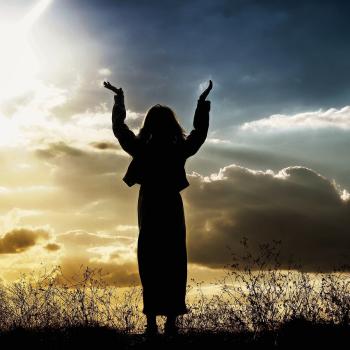
What is the True Nature of Prayer? – Part 2
In Part 1 of this article
(https://www.patheos.com/blogs/companionsonthejourney/2021/12/prayer),
it was suggested that the traditional notion of prayer might at this point in history be due for deeper analysis and understanding.
Traditional religious systems often assert that the core revealed teaching must be considered as whole, complete, and unchanging for eternity — the “eternal truths”. Yet just as knowledge must be made simple for a childhood stage of development until the collective mind is capable of processing more sophisticated knowledge, spiritual truths might similarly take on new and deeper meaning as we continue to learn, grow, and evolve as a species and culture.
Note that through the millennia, the term “prayer” itself has taken on many connotations, some of which may seem trite, sentimental, or superstitious. The reader is urged not to prematurely dismiss the following on this basis. If the term “prayer” is a stumbling block, you may substitute “directed quantum decoherence” (though it is a bit more unwieldy.)
What follows then, are some exploratory thoughts about the meaning of prayer in light of current understanding of the sciences, human psychology, and of the cosmos at large. Despite many claims to the contrary, perhaps there may be an intersection between science and spirituality after all.
To fully explore this topic would require a textbook, but as a first-pass high-level overview, we will consider the following topics in a series of blogs. (The first six topics are not specifically about prayer, but are necessary prerequisites for final theory.)
– What is Consciousness?
– What is Matter?
– What is the World?
– What is Time?
– What is Life?
– What is the Self?
… and finally,
– What is Prayer?
What is Consciousness?
Perhaps a simple, rock-bottom definition of consciousness that both metaphysicalists and scientists might agree upon would be: “A change in perceptual state due to interaction with a phenomenon perceived as ‘other’ to the perceiving/experiencing entity”.
In contemporary science, this ability to have subjective conscious experiences, is held to be an end-product of evolution, once the nervous system has reached a sufficient level of complexity. Some go so far as to suggest consciousness is merely epiphenomenal — an illusion — something that rides along with physical activity but has no real causal effect. (These are mostly the “there is no free will” crowd.)
Yet the fundamental nature of consciousness – its actual mechanism – continues to be known as “The Hard Problem” (as coined by philosopher David Chalmers). No satisfying explanation has yet emerged to show how the random interactions of subatomic particles and forces should end up producing the works of Shakespeare, the inspiration of poetry and music, the experience of the taste of chocolate, or other abstractions.
Especially in the West, it is common to think of consciousness as something that people “have”. A debate then follows as to how far down the ladder of complexity does consciousness go. When defined as self-awareness, many agree that apes and dolphins have consciousness. When defined as the ability to have subjective experience, we anesthetize house pets for surgery because we believe they can experience pain and terror. What about birds? Insects? Plants? Rocks? Cells? Atoms? What about fields and forces? Though it may be anthropomorphizing, it is difficult to image these as having consciousness.
Yet what if the situation were actually the reverse?
More recently, some in the sciences have begun to revisit a notion common in older spiritual traditions like Hinduism — that consciousness is actually the primary, fundamental factor in the universe, and that the material world is derivative from a “cosmic consciousness”. In other words, people (and whatever else) don’t have consciousness but rather people, plants, rocks – even stars and galaxies, are all phenomena that occur within a universal consciousness.
Two books on this topic were cited in Part 1 of this article, and we won’t revisit them here. But suffice it to say that every practical, scientific observation, every measurement, category, model, and theory originated as an experience in someone’s consciousness.
In such a consciousness-primary universe, individual, subjective consciousness occurs as a holographic fractal of the Whole — the cosmic “Big C” consciousness. Fanciful as this may sound, Quantum Field Theory actually provides an interesting model as to how this may occur. This is explored in the next section.
What is Matter?
Early in human history, it was thought that the world was made up of four basic elements: earth, air, fire, and water. Along came the Greeks, who proposed that these were themselves made up of far smaller units: atoms — something that could not be subdivided further. Yet in the early 20th Century, this “floor” of existence was found to extend still deeper. Atoms are composed of units (electrons, protons, neutrons), which are themselves composed of units (or ‘quanta’ – quarks, gluons, photons, etc). Moreover, it has not been ruled out that something still more fundamental may exist (eg. String Theory, supersymmetric particles).
Throughout this progression, matter was found to be less and less substantial — more a form of energy, leading to Albert Einstein’s famous equation (E = mc^2).
One puzzling but commonly accepted aspect of this is the “wave-particle duality” — the finding that a particle (e.g. electron) can act as a wave or as a particle, depending upon the way the measurement it taken. In answer to the common sense question, “which is it really?” the scientific answer is “both”. Before the observation is made, the electron exists in an indeterminate state, holding both possibilities. Yet once measured, it persists in whichever state was observed. It’s sort of like taking a snapshot, which then holds one particular perception going forward,
Of course science marches on, and the latest thinking in Quantum Field Theory holds that the wave aspect actually is dominant. Not only electrons, but all particles are essentially “virtual” particles — existing as fluctuations in their corresponding underlying field. Even Einstein, though himself skeptical of quantum physics, indicated at one point that “The field is the sole governing agency of the particle.”
Every “particle” then, is sort of like a wave crest in its associated field. And a key point is that these fields are universal – they extend throughout the universe. (So, when New Age / spiritualist-types assert that “we are all connected” or “everything is part of one Whole”, this is probably how it would work.)
Ocean waves provide a helpful analogy. Wave crests are not independently existing “things” but are simply temporary fluctuations in the underlying “field” of water. Yet despite such non-existence, wave crests can do significant work — move a surfer, move or impede a ship, or even destroy other materially existent things in the form of a tsunami.
What is the World?
“No phenomenon is a real phenomenon until it is an observed phenomenon.”
— John Archibald Wheeler
In view of the previous section, objects in the everyday world are composed of uncountable arrangements of subatomic “wave crests” which coalesce into the atoms, molecules, materials, structures, and eventually the objects we are familiar with (including our own bodies).
If the wave/ocean analogy holds, the deep structure of reality is one universal field of potential — all possible realities, not “parallel”, but superposed. Yet what is it that causes one reality to emerge from an infinitude of potentiality? We here consider the proposition that a universal consciousness is the primary factor in the existence of all. (This proposition is reemerging in contemporary philosophy under the label “Analytic Idealism”.)
So on this basis, how would the everyday world come to be in its present form? Following is one hypothesis:
The “coalescences” might occur in stages, through the observational attention/intention of a universal (Big C) Consciousness. That is, from a subtle as-yet undiscovered layer of existence (perhaps David Bohm’s “implicate order”), emerge the various fields that comprise subatomic phenomena. These fields then bundle into the various “particles” that comprise atomic structure. Beyond this, a series of successive bundlings might then emerge as modules that comprise structures of increasing complexity — on up to living systems.
We commonly think of conscious creation as something done by a living entity, attending to and manipulating materials in the environment in order to create (“bundle together”) something new — be it a bird’s nest or a rocket ship. Yet according to the present hypothesis, these preexistent materials themselves preexist due to attentional bundling by a larger all-encompassing Consciousness.
We experience a stable, persistent, commonly shared cosmos and world due to the bundlings (constructions) that occurred long before the emergence of life as we know it, as well as abstract, individual consciousness.
Following on this, we have stable, commonly shared experiences of life, society, and culture, as well as the daily infrastructure we all depend upon (pots, pans, houses, cities) due to the bundlings created (and generally shared) by individual subjective consciousness.
Continuous Creation
A final (and probably controversial) point: our common, daily experience is that of a stable, persistent world that exists with or without us, before and after us — whether or not we are aware of it. However, if consciousness is in fact primary and universal, and if the base existence of matter is fleeting virtual particles, then the existence of all must be “observed” into reality moment by moment.
“Not once in the dim past, but continuously, by conscious mind, is the miracle of creation wrought.”
— Sir Arthur Eddington
This would certainly be an impossible burden for individual, subjective consciousness, but fortunately the task is borne by consciousness at greater levels.
Yet this does offer an opportunity for the individual, in that much more of our own experience is likely within our influence than we commonly realize. While we may not violate the basic laws of physics, our individual experience may be substantially altered by how we use our powers of observation and attention.
“On whatever you place your attention, that becomes your reality.”
— William James
















